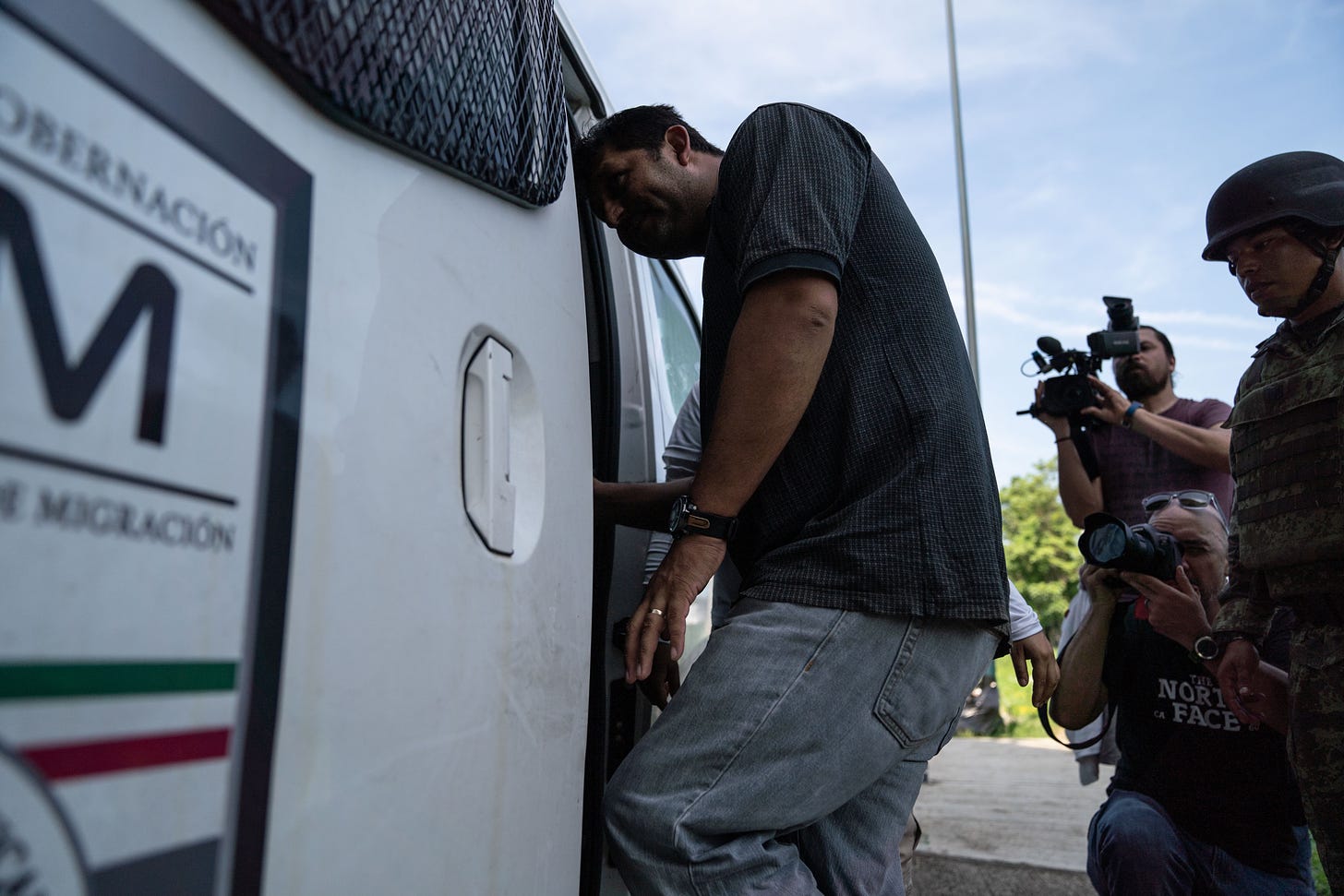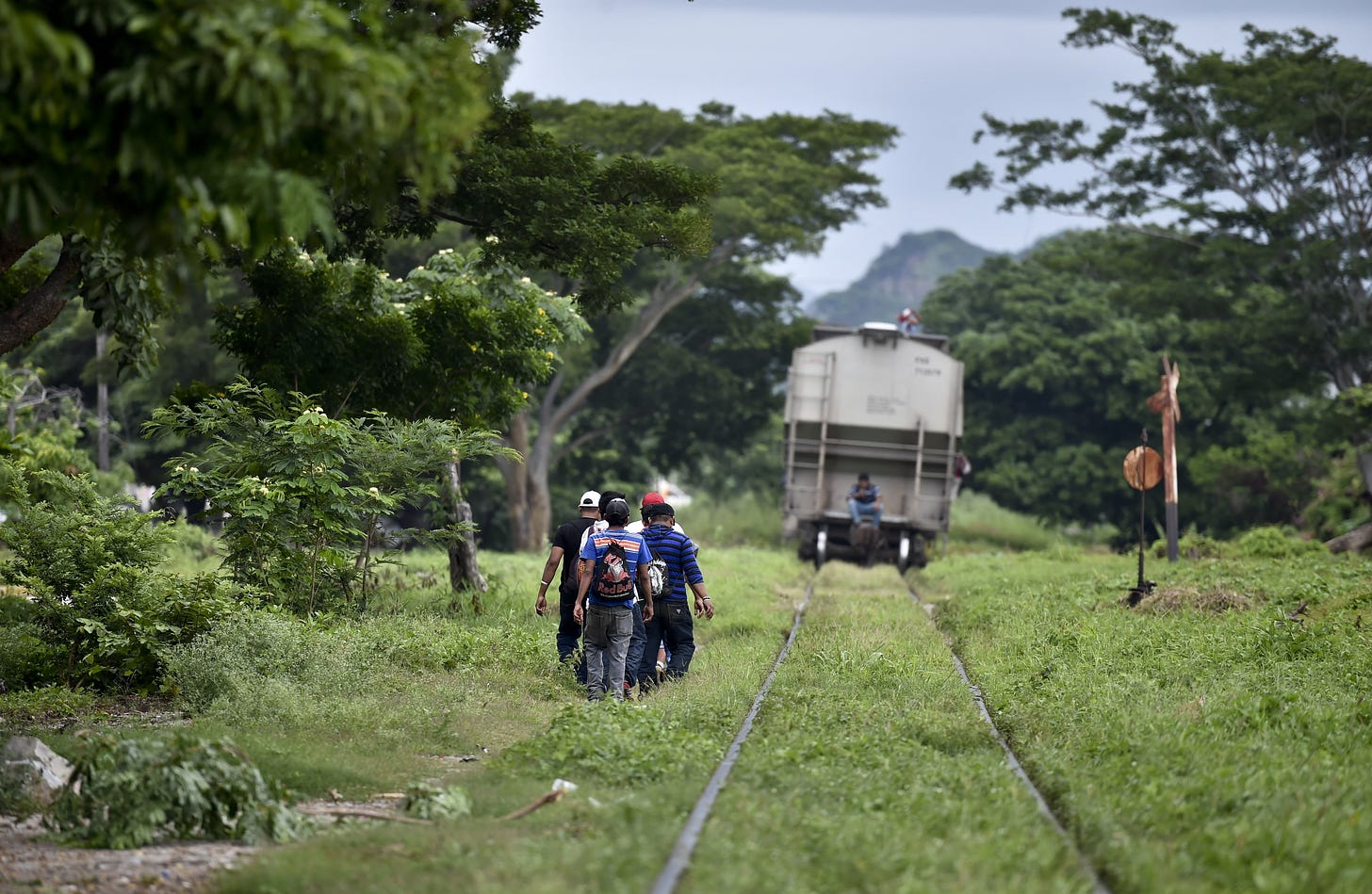Editor’s Note: The following article was originally published by Todd Miller on The Border Chronicle on October 17, 2024.
On October 1, near the Mexico-Guatemala border close to Tapachula, Chiapas, the Mexican military opened fire on trucks filled with migrants. They killed six people from Honduras, Peru, and Egypt—including an 18- and an 11-year-old—and wounded many others. The military said they shot because the trucks failed to stop and because they heard “detonations.” The Human Mobility Pastoral (of the Episcopal Conference of Mexico’s Catholic Church) cited a different reason. They described the killing as a “consequence of the militarization of immigration enforcement and the increasing presence of the armed forces on the southern border.”
This implicates the United States. Mexico’s southern border has long been in the crosshairs of U.S. border policy, and its militarization has come with pressure, funding, and training from Washington. “Mexico is the wall,” Josue Martínez, a psychologist at a shelter for migrants in Villahermosa, Tabasco, told the Associated Press in June.
More than a decade ago a prominent U.S. Department of Homeland Security official said basically the same thing: Chiapas’s frontier with Guatemala is the southern flank of the U.S. border.
Perhaps that was what President Joe Biden had in mind on December 20, 2023, when he called then Mexican president Andrés Manuel López Obrador—on the cusp of an intense election year in which it was clear that the border would be under scrutiny. Biden told the Mexican president that “he was worried about the situation on the border because of the unprecedented number of migrants arriving.” The next day, the White House reported that the presidents had come to an agreement and “that additional enforcement actions are urgently needed.”
And so began the Mexican “crack down,” as the AP put it. In true holiday spirit, Mexico detained more migrants than the United States, averaging about 9,500 a day (up from 8,000 before that). By June, Biden had announced asylum restrictions and said he had “drastically” reduced migration to the border thanks to his arrangement with López Obrador. Indeed, people arriving to the U.S. border had gone down by 40 percent.
Mexico’s increased enforcement has not come in the form of mass deportations. Rather, Mexico has implemented an “estrategia de cansancio,” as Nancy García, cofounder of the NGO MANOS (Migrantes Apoyados, No Olvidados), told me in Oaxaca City last week: a strategy meant to wear people down. It’s another tentacle of the deterrence strategy that has been so fundamental to U.S. immigration enforcement.

Checkpoints clog the roads headed from Chiapas north to Mexico City, including through Oaxaca, especially in the state’s Isthmus of Tehuantepec region. At checkpoints, García told me, immigration pulls undocumented people off buses and confiscates what little money they have, but they do not deport anybody. They return people to areas farther south but within Mexico. The agents of the National Institute of Migration, García told me, “don’t give migrants food, don’t give them medical attention. They just detain them, move them to another place, and then leave them.” This happens after the migrants have traveled north for days or weeks or even months. They become disoriented, feeling defeated, as if they are never getting anywhere. García said people have gotten pushed back so many times that many have told her they are “exhausted” and just “want to go back.” In June, Venezuelan migrant Yeneska Garcia told the AP that she would “rather cross the Darien Gap 10,000 times than cross Mexico.”
According to Nancy García, what makes Mexico so difficult is the convergence of two dynamics: hypermilitarization and increased organized crime in Chiapas. Mexico is becoming a thousand-mile border wall. Added to this are the difficulties with using the CBP One app, and figuring out which regions you can use it in to apply for asylum.
While the Biden administration’s pressure on Mexico comes during an election year—and the Democrats have made a tough-on-the-border stance central to their campaign—this sort of collaboration between the United States and Mexico has been going on for decades through multiple administrations. There is a genius to this for Biden, as well as for Kamala Harris and other Democratic candidates: fewer arrivals at the U.S. border mean they can tout their border policy as effective, an important counterpoint to the Republicans’ constant slew of “open borders” accusations. What’s more, the pressure on Mexico to further militarize its borders will either go unnoticed in the often-myopic U.S. national media, or it will be framed as “diplomacy,” as The New Republic did in a column by Greg Sargent in August.
But U.S. border externalization has always been more about pressure than diplomacy, and it is more than just a short-term campaign strategy.
For two decades U.S. officials have asserted that extending the border is a fundamental part of their strategy to stop people from reaching the U.S. international boundary. In 2014, I went on a reporting trip to Chiapas after Mexico announced its new border-enforcement plan, called the Programa Frontera Sur, to witness the aftermath of immigration sweeps that were in part funded by the United States through the Merida Initiative, a multibillion-dollar military aid package that started during the George W. Bush administration, continued through the Obama administration, and designated a significant amount of money to what it called building a “21st-century border.” I went to the small town of Arriaga (2,000 miles southeast of the Arizona-Mexico border), where during the 2014 operation most people ran and then hid from authorities on the outskirts of town—with exhausted, sometimes scared looks on their faces, hoping a train would soon go by. I talked to one man, a butcher from Chimaltenango, Guatemala, who told me he had tried to cross four times and was arrested and deported every time. Except this time. He pulled out a picture of his child who lived in Miami to show me why he wouldn’t give up.

By 2015, Mexico had topped the United States in Central American deportations, a trend that would stay in place for several years, based on a collaboration that included, as an official told me at CBP headquarters in Washington, DC, in 2018, 15 phone calls going on at any given moment between U.S. and Mexico border and immigration enforcement authorities. The Merida Initiative provided funding for biometric kiosks and other technologies, helicopters, trainings by CBP in Mexico, checkpoints, and weapons, among a host of other things. In other words the collaboration is based on a well-established, multipronged infrastructure.
As García told me, the 2024 strategy does not include deportation; it is more about causing suffering and exhaustion. And the cornerstone to most border-enforcement strategies is increasing the possibility of death. Death by exhaustion, death by the elements, death by exposure. Or death because you travel hidden in vehicles to evade authorities. To name a few incidents: In October 2023, also in Chiapas, a vehicle carrying migrants crashed and killed 10 people. In 2022, another crash killed 40. Also in 2022, 53 died in a suffocating, broiling truck in San Antonio, showing that this happens on both sides of the linea. Also in 2021, Mexican authorities killed 17 people in the state of Tamaulipas in an incident similar to the one on October 1. This time the people in the vehicle came from all over the globe: Nepal, Cuba, Pakistan, and India.
The October 1 killing in Chiapas coincided with the inauguration of Mexico’s new president, Claudia Sheinbaum, who condemned the incident as “deplorable.” She said the two soldiers who fired were turned over to civilian authorities. “In our country,” she claimed, “there is no state of siege. There are no violations of human rights.” In June, Biden affirmed that the United States would work with the Sheinbaum administration as it had with López Obrador’s. The relationships were in place. The border wall that Trump insisted Mexico would pay for in 2016 has been built, but in a way much different from how anyone imagined it.
El Tribuno del Pueblo brings you articles written by individuals or organizations, along with our own reporting. Bylined articles reflect the views of the authors. Unsigned articles reflect the views of the editorial board. Please credit the source when sharing: tribunodelpueblo.org. We’re all volunteers, no paid staff. Please donate at http://tribunodelpueblo.org to keep bringing you the voices of the movement because no human being is illegal.



